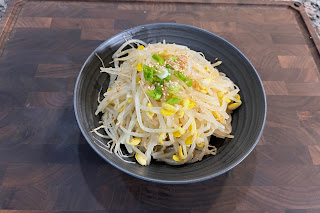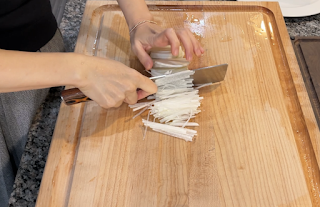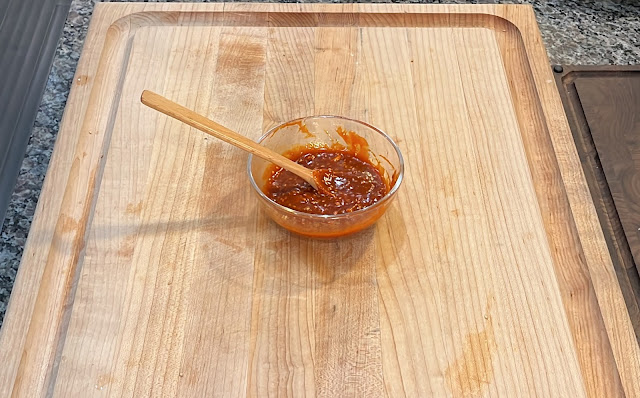- Get link
- X
- Other Apps
- Get link
- X
- Other Apps
SUPER FLAVORFUL and HEALTHY Vegetarian Bibimbap
Hello everyone! It’s great to see you again! These days
when going to the store, I have noticed so many fresh vegetables that caught my
eye. I thought it would be perfect to bring my favorite vegetables together to
make this delicious Bibimbap. The ingredients are all easy to find and the
taste is extra fresh! Hope you enjoy this recipe!
Ingredients: 12 oz radish, 10 oz soy bean sprouts, 1
bunch spinach (9 oz), 1 zucchini, 1 cucumber, dried mushrooms
Bibimbap sauce: 2T red pepper paste, 1/2T sesame oil,
1/2T sugar, 1T water
How to make it
Step 1: Stir-frying Mushrooms (Beoseot bokkeum)
Let me show you how to make stir-frying mushrooms,
beoseot bokkeum. Soak dried shiitake mushrooms in water for 2 hours or so. 2
hours later, wash it once in water and put it in a strainer. Squeeze out the
water. Add 2 pinches of salt, a bit of minced garlic, 1 tbsp of sesame seeds, 1
tbsp of sesame oil. Before stir-frying, gently mix it with your hand. Stir-fry
on medium-high heat for 2-3 minutes.
Step 2: Soy bean sprouts side dish (Kongnamul muchim)
Put the washed bean sprouts in boiling water. Boil for 2
minutes. Drain the blanched bean sprouts in a strainer and soak them in cold
water. Then the bean sprouts will have a crisper texture. Add two pinches, a
bit of garlic,half a tablespoon of sesame oil, and 1 tbsp of sesame seeds. Mix
it well. Crispy soy bean sprouts namul is done!
Step 3: Spinach side dish, Sigeumchi namul
Add half a tablespoon of salt to the boiling water. Add
the washed spinach to boiling water. Blanch it for about 1 minute. Wash the
boiled spinach well in cold water. Cut the spinach a few times. And make sure
to squeeze out the water. Put two pinches of salt, a bit of garlic, 1 tbsp of
sesame oil, and 1 tbsp of sesame seeds. Mix it well. Easy and simple sigeumchi
namul is done!
Step 4: Spicy Radish salad (musaengchae)
Slice the radish into thin slices and then thinly slice
it again. Put the shredded radish in a bowl. Add two pinches of salt and mix it
well. Let it sit for about 10 minutes. After 10 minutes, squeeze out a moderate
amount of water. Add 1 tbsp of red pepper powder. Add 1 teaspoon of garlic, a
bit of ginger, 1 tbsp of sesame seeds. It's already seasoned, so you don't need
to add salt. Mix it well.
Step 5: Cucumber salad (oi muchim)
Cut the cucumber in half. Remove the seeds inside. Then,
cut it into half-moon shapes. Put the sliced cucumbers in a bowl. And add two pinches
of salt. Mix it well. Let it sit for about 10 minutes. After 10 minutes,
squeeze the cucumber by hand. Add some garlic to the cucumber, 1 tbsp of sesame
seeds, 1 teaspoon of sugar, and half a tablespoon of sesame oil. Mix it well.
Step 6: Stir- fried Zucchini (Hobak bokkeum)
Cut the zucchini in half. Thinly slice in half-moons. Put
the sliced zucchini in a bowl. Sprinkle with about two pinches of salt. Mix it
well. And let it sit for about 10 minutes. After 10 minutes, squeeze out the
water from the pickled zucchini. Add a bit of garlic, 1 tbsp of sesame oil, and
1/2 tbsp of sesame seeds. Fry it well.
Step 7: Making Gochujang sauce
Put 2 tablespoons of red pepper paste in a bowl. Add half
a tablespoon of sugar. Add half a tablespoon of sesame oil. Add 1 tbsp of
sesame seeds. Add 1 tbsp of water. Mix it well. It is good if you put pine nuts
in bibimbap sauce. If you don't have pine nuts, you can add walnuts. If not,
you can take it out. This is dried jujube. Remove the seed. I will roll it up
and cut it thinly. I will use it as a garnish on top of bibimbap. If you don’t
have it, you can take it out.
Step 8: Plating
Put the rice in a bowl. Put the prepared ingredients one
by one. Place the stir-fried zucchini(hobak bokkeum), stir-fried mushrooms
(boeseot bokkeum), and put soy bean sprouts side dish (kongnamu muchim). Add
spinach side dish (sigeumchi namul) and cucumber salad (oil muchim). Lastly,
add spicy radish salad (musangchae). Add the appropriate amount of bibimbap
sauce and mix when you eat bibimbap. Beautiful and healthy vegetarian bibimbap
is done!
Doesn’t this Bibimbap recipe look so healthy and
delicious? I think it’s great how so many fresh ingredients can come together
to make such a wonderful and tasty dish. I hope you all get the chance to enjoy
this yummy recipe. I’ll see you next time, bye bye!
Ingredients
- 12 oz radish
- 10 oz soy bean sprout
- 1 bunch spinach (9 oz)
- 1 zucchini
- 1 cucumber
- some dried mushrooms
Bibimbap sauce
- 2T red pepper paste
- 1/2T sesame oil
- 1/2T sugar
- 1T water
Notes
- Pour about the similar amount of water as the soaked rice into the pot.
- If you go to a Korean food store, you can buy dried shiitake mushrooms.
- Personally, I use dried shiitake when making bibimbap because it has a better texture. If you do not have dried shiitake, you can just use fresh mushrooms.
- In Korea, Korean soy sauce is also sometimes used instead of salt when make Korean side dish, namul.
- It is said that the radishes that come out in the fall are the sweetest and most delicious.
- If chopping radishes is inconvenient, you can use a slicer.
- Ingredients for bibimbap are mixed with red pepper paste at the end, so it is better to season it a little less than usual. If you season it as usual, the bibimbap can end up being a bit salty.
- It is called bibimbap because it means to eat rice while mixing in other ingredients.
Check out My Amazon Page💜: https://www.amazon.com/shop/chungskfood
- Get link
- X
- Other Apps

.JPG)




























.JPG)
Comments
Post a Comment